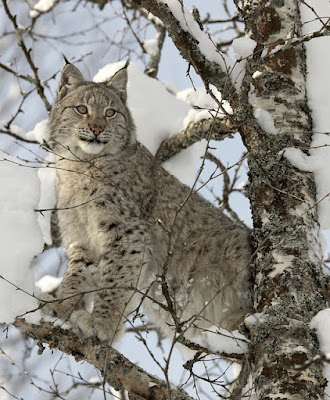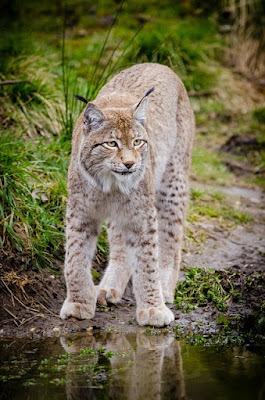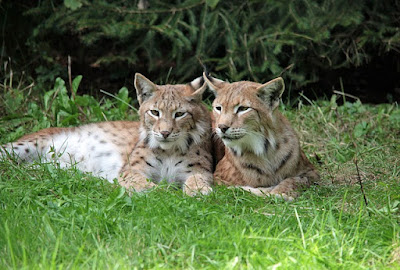The majestic lynx: a secretive predator
A charismatic and elusive cat, the lynx holds a special place in the hearts of nature lovers and wildlife admirers alike. With its distinctive tufted ears, fur-covered paws and piercing gaze, the lynx embodies the wild spirit of the northern forests it calls home. In this article, we'll delve deeper into the world of the lynx, exploring its habitat, behavior, and importance in the ecosystem.
Habitat and Distribution:
Lynxes are medium-sized wild cats that inhabit the vast boreal and temperate forests of North America, Europe, and Asia. There are four main species of lynx: the Eurasian lynx (Lynx lynx), the Canadian lynx (Lynx canadensis), the Iberian lynx (Lynx pardinus), and the bobcat (Lynx rufus). These species are distributed in a wide variety of landscapes, from dense forests and mountainous areas to taiga and shrublands.
Physical Characteristics:
Lynxes are characterized by their short tails, long legs, and distinctive facial features. The most striking aspect of their appearance is their ear tufts, which are believed to enhance their ability to hear. These tusks, combined with their sharp vision and well-developed senses, make lynxes exceptional hunters, able to locate prey even in challenging conditions.
Their fur coats vary in color, ranging from reddish-brown to greyish-brown, providing excellent camouflage among their wild habitats. Their fur also becomes thicker during the winter months, helping them cope with the colder temperatures.
Behavior and Hunting:
Lynxes are mainly solitary creatures, with males and females coming together only during the breeding season. They have large territories which they defend vigorously, using scent marking and vocalizations to establish their presence without direct confrontation.
Their hunting ability is remarkable. Lynx are skilled stalkers and ambush hunters, often relying on their extraordinary patience and agility to capture prey. Their diet consists mainly of small mammals, such as snowshoe hares, rabbits, and rodents. These animals are vital to the lynx's survival, and their populations often fluctuate in sync with the abundance of prey species.
Conservation Status and Challenges:
While the lynx has managed to maintain a relatively stable population, it faces some challenges, especially in specific areas. The Iberian lynx, for example, is one of the most endangered wild cat species in the world, with habitat loss and prey population decline being significant threats. Conservation efforts are underway to protect and restore its habitat, along with captive breeding programs to increase its numbers.
In other areas, habitat fragmentation and human activities pose challenges to lynx populations. Sustainable forestry practices and responsible land management are vital to maintain the delicate balance between human needs and the well-being of these magnificent creatures.
Cultural and Symbolic Significance:
Throughout history, lynxes have captured the human imagination and cultural significance. In ancient civilizations, the lynx was associated with characteristics such as keen observation, intuition, and mystery. Its elusive nature and silent presence in the forest has made it a symbol of independence and self-reliance.
In some indigenous cultures, the lynx is revered as a guardian of the forest, symbolizing the spirit of the forest. Its presence in stories, art, and rituals has cemented its role as a creature of mythological importance.
The lynx, with its mysterious demeanor and excellent hunting skills, stands as testament to the wonders of the natural world. From the northern reaches of North America to the ancient forests of Europe and Asia, these majestic creatures roam as guardians of the wilderness. As we continue to strive for harmony between human activities and nature, the conservation of the lynx and its habitat serves as a reminder of the delicate balance that sustains life on our planet.
Here are some interesting facts about Lynx:
- Distinctive ear tufts: One of the most recognizable features of the lynx are their tufted ears. These flakes aren't just for show; They actually enhance your hearing by helping to conduct sound into your ear canals.
- Different Species: There are four main species of lynx: the Eurasian lynx, the Canadian lynx, the Iberian lynx, and the bobcat. Each species has adapted to its specific habitat and environment.
- Territorial Animals: Lynx are known for being solitary and territorial animals. They establish and defend their territories using scent markings and vocalizations to communicate with other lynxes.
- Nocturnal hunter: Lynx are primarily nocturnal, meaning they are most active during the night. This behavior helps them avoid human activities and have less interaction with potential predators.
- Camouflage Masters: Their fur coats come in various shades of brown and gray, making them adept at blending into their wild environments. This camouflage helps them both to hunt and to avoid predators.
- Typical diet: Lynx are carnivorous and prefer small mammals. Their diet mainly consists of animals such as rabbits, hares and rodents. In fact, the snowshoe hare is the primary food source for many lynx populations.
- Boom and bust population cycles: Lynx populations often experience cyclical fluctuations based on the abundance of their primary prey species. This phenomenon is known as the "Lynx and Hare cycle".
- Winter Adaptations: To survive harsh winter conditions, lynxes have coats of thick fur that keep them warm. Their paws are also covered in fur, which act like snowshoes, helping them move over deep snow.
- Incredible Jumpers: Lynx are impressive jumpers and can leap up to 10 feet (3 m) horizontally. This ability helps them catch agile prey such as birds and squirrels.
- Conservation concerns: While some lynx populations are stable, others are endangered. The Iberian lynx, for example, is critically endangered due to habitat loss and the decline of its primary prey species, the European rabbit.
- Cultural Significance: Lynx has had symbolic significance in various cultures throughout history. They are associated with such qualities as mystery, intuition and independence.
- Hybridization: In some areas where the ranges of different lynx species overlap, hybridization can occur. For example, the Eurasian lynx and the Canadian lynx can interbreed.
- Communication: Lynx communicate with each other through vocalizations, which include meows, growls, and hisses. They also use scent marking to establish their territory and to communicate with other lynxes.
- Role in the ecosystem: As apex predators, lynxes play an important role in regulating the populations of their prey species. This has a cascading effect on the entire ecosystem, affecting plant growth and other animal populations.
- Human contact: While lynxes generally avoid human contact, there have been incidents of encounters between lynxes and people, especially in areas where their habitats overlap.




Comments
Post a Comment